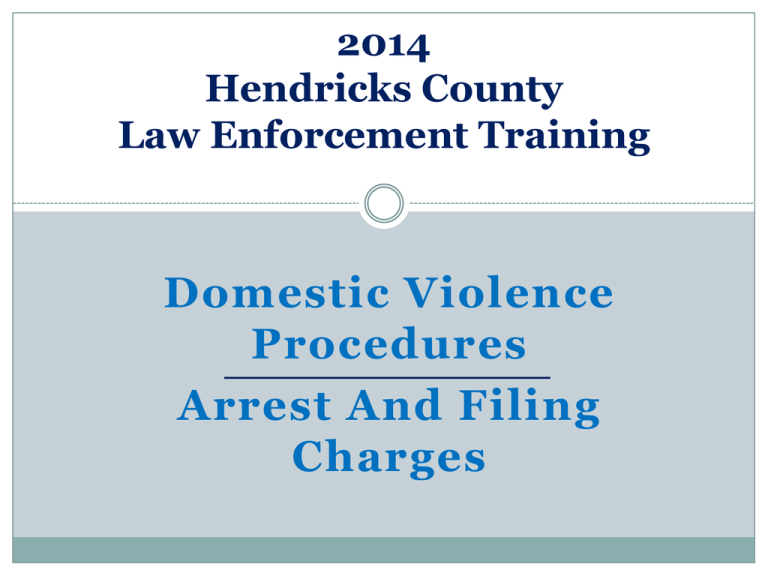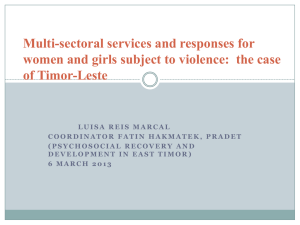
2014
Hendricks County
Law Enforcement Training
Domestic Violence
Procedures
Arrest And Filing
Charges
2013 State of Domestic Violence In
Hendricks County
Homicide on 6/8/2013 - Trinity Ann Johnson, 19 years old, Avon, was allegedly shot by her
boyfriend, Antonio Miles, 20. She left behind an infant.
The total number of domestic violence runs by local law enforcement, as reported by
individual departments, has decreased 3.5% in 2013. Plainfield (+28%) and Danville (+52%) had an
increase in runs, while Brownsburg (-34%) and HCSD (-10%) decreased. Avon remained constant.
The majority of arrests were made by the HCSD, followed by Plainfield, Avon, Brownsburg and
Danville, respectively.
The Hendricks County Prosecutor had an 8.5% drop in the number of domestic violence charges
filed in 2013. Charges that are filed most frequently are domestic battery both misdemeanor and
felony and invasion of privacy. These changes accounted for 62% of all DV cases. The number of DV
cases filed as also decreased. While a decrease is encouraging, we had many extremely violent cases
including: murder, strangulation (12), battery with a deadly weapon (5), and abuse of a corpse. May,
July and September were the most active with new filings.
The Lethality Assessment Program for law enforcement continues to link victims to resources at
the scene of a domestic violence incident. The number of officers implementing the protocol and
victims receiving the benefits is at the highest level in our five year history. In 2013, four families were
housed at Sheltering Wings and eight families received outreach services as a result of LAP. We would
like to increase the number of families receiving assistance during follow-up.
Sheltering Wings housed 118 families and responded to over 1,000 crisis calls. Connet2Help 211
had an increase of 52% in domestic violence assistance calls for 2012 from Hendricks County. We
have the highest level of requests for the donut counties.
Complete Report: http://hccadv.org/2012StateofDV.pdf
Definitions
Family Violence—Any intentional act committed by one member of a
family against another which causes or risks bodily harm. Under
Indiana law, any act of family violence is a crime.
Domestic Violence—Violence between intimate partners who have
shared a marital-like relationship (spousal assault, conjugal violence,
wife battery). Indiana law defines most acts of criminal violence among
adults regardless of relationship.
Child Abuse—Neglect or family violence committed by an adult against a
child. Acts of neglect or family violence against a child are crimes. The
type of crime depends on the ages of victim and offender.
Abuse of elderly and disabled adults—Family violence committed
against elderly, endangered, or dependent persons. Crimes are defined
according to victim-offender relationship and dependency, without
regard to age.
Dating Violence - The physical, sexual, or psychological/emotional
violence within a dating relationship. Indiana has the 2nd highest rate of
dating violence in the country with 17.3% of girls raped before they
graduate.
Crimes of Family Violence
Battery
Domestic battery
Strangulation
Aggravated battery
Attempted murder
Aggressive Driving
Criminal recklessness
Pointing a firearm
Disorderly conduct
Invasion of privacy
Trespass
Criminal deviate conduct
Rape
Sexual battery
Child molesting
Residential entry
Burglary
Intimidation
Harassment
Stalking
Criminal confinement
Violation of a custody order
Sexual misconduct with a minor
Child exploitation
Promoting prostitution
Vicarious sexual gratification
Child seduction
Incest
Neglect of dependent
Nonsupport of dependent child
Nonsupport of spouse
Nonsupport of parent
Exploitation of dependent adult
Common DV Crimes – Domestic Battery
A person who knowingly or intentionally touches a person who
(1) is or was a spouse of the other person,
(2) is or was living as if a spouse of the other person, or
(3) has a child in common with the other person,
in a rude, insolent, or angry manner that results in bodily injury . . .
commits domestic battery, a class A misdemeanor.
The offense is a class D felony if
the person has a previous, unrelated conviction for domestic
battery or for a substantially similar crime of domestic violence
against anyone, anywhere.
the crime is committed in the presence of a child.
Common DV Crimes – Stalking
Intentional repeated or continuing harassment causing a victim to
feel terrorized, frightened, intimidated, or threatened
Hendricks County Prosecutor, Pat Baldwin recommends the following action on
stalking cases:
There is not a certain number of events that equals stalking, it will vary
with each situation. As a general rule we are probably looking at a
minimum of 3 separate actions.
However, multiple IOP doesn’t necessarily mean there is stalking. A series
of phone calls might never equal stalking.
It has to be repeated or continuing, and it has to be such that a reasonable
person to feel terrorized, frightened, intimidated or threatened, and actually
cause the victim to feel that.
If you have questions: bring in your report, and go over it with a prosecutor
to decide if stalking should be filed.
Protection Orders and Invasion of Privacy
A protection order is a
court order prohibiting
one person from
abusing, harassing, or
disturbing the peace of
another person, or from
having contact with
another person.
Indiana law defines
violation of a protection
order as invasion of
privacy (IC 35-46-115.1).
Protective order
• Issued at the request of victim/petitioner
• Respondent need not be present in court
• Resp. may request hearing within 30
days
• Normally in effect for 2 years
No contact order
• Issued by criminal court as condition of
pretrial release or probation
• Respondent notified in court
• In effect during entire court proceeding
Workplace violence restraining order
• Issued at the request of employer to
protect employee from violence at work
• Court hearing within 15 days
• In effect for not more than 3 years
Foreign protection order
• Order issued by another state or Indian
tribe
• Enforced as if issued by Indiana court
More On Protective Orders
Firearms
IC 34-26-5-9(c)(4)
(The court) may order the
respondent to refrain from
possessing a firearm . . . (if) the
respondent poses a significant
threat of inflicting serious bodily
injury to the petitioner or a
member of the petitioner’s
household or family.
If a gun is in the home of an abused
women, she is 5 times more likely
to be killed with it.
Foreign Protection
Order Enforcement
IC 35-46-1-15.1(10), (11)
A person who knowingly or
intentionally violates an order
issued in a state other than
Indiana, or by an Indian tribe,
that is substantially similar to an
order described under IC 35-461-15.1 for Indiana commits
invasion of privacy.
Indiana officers may arrest for
violations of other states’ or
Indian tribes’ protection orders
General Guidelines for Police Response
to Domestic Violence
1. Protect Against Threats to
Safety
2. Secure the Scene for Disputant
Safety
3. Calm the Situation
4. Investigate
5. Act to Protect the Victims
Officer’s Responsibility
Investigate thoroughly
Assume that a crime was committed.
What was the crime?
Who did it?
Any elements of probable cause to arrest?
Were children present?
Have you protected a victim’s right to self-defense?
Does evidence require calling in police detectives
or other
Act to prevent further violence
Complete Domestic Violence Supplemental – Sections
A and B
More Officer’s Responsibility
IC 35-33-1-1.5 Police officers responding to the
scene of family violence are required to “use
all reasonable means to prevent further
violence, including the following”:
transporting the victim and children to a safe place
assisting in removing victim’s family necessities
giving written notice of rights to victims
removing firearms, ammunition, or other deadly weapons,
under certain conditions
Police Response to Domestic Violence
Investigate thoroughly.
If you find probable cause, arrest.
Complete the Domestic Violence Supplemental.
Administer the Lethality Assessment Screen on victims
and follow protocol.
Give victims Domestic Violence Resource Card and
“Victim Rights.” Complete “Victim Notification” for the
jail.
Offer whatever assistance you can to prevent further
violence.
Make a report and indicate domestic violence was
involved, even if you don’t arrest.
Probable Cause and Evidence
- Photographs injuries or no injuries
- Photos of residence and any damage to walls, vehicles,
etc.
- Record any victim statements, witness statement, or
neighbors. Please have the victim and other witnesses
write out statements.
- List witness contact info on the case report
- Use descriptive language in the PC. The case has to be
“brought back to life” through the PC in court.
- Completed all victim contact info on Side A of the DV
Supplemental including alternative contact info
ARREST to Prevent Further Violence
Warrantless Arrest for Domestic Battery
can prevent further violence.
Arrestee will be held for a “cooling off period” of at least 8
hours. Please complete “Victim Notification” in
Supplemental Packet and give to jailer so victim will be
notified prior to offender’s release.
Arrestee may not have contact with the victim for 10
days after release from jail or until the initial hearing,
whichever occurs first.
Do not ask the victim whether he or she wants the
offender arrested or prosecuted
Side A
Complete Domestic
Violence Supplemental Side A on all domestic
violence runs, with or
without arrest.
Domestic violence
crimes defined on slide
#4. Submit to the
Prosecutor even when
arrest does not occur.
The Lethality Assessment (LAP) is part
of the packet prosecution needs to
present their case. It helps with
recanting victims and in bond hearings.
It needs to be completed on all DV
related cases: domestic battery, IOPs,
harassment, stalking, intimidation,
sexual battery, rape, etc.
Side B
Complete Domestic
Violence Supplemental Side B on all domestic
violence runs that result
in an arrest. Side A
should also be
completed and
submitted to the
Prosecutor with your
report.
Children as Witnesses
Contact Department of Child Services Immediately if children are in the
home and any of the following exist:
1. Signs of injury to adults or child(ren)
2. Drugs or weapon found in the home when a domestic battery has
occurred
3. Officer believes DCS presence is necessary based on
circumstances of the family
Contact Department of Child Services within 24-hours if:
1. Officer has suspicion that family violence exists or that a child
may have witnessed the violence.
If no arrest is made and the situation is volatile, stay in the home until
DCS arrives, if possible.
Contact Susie’s Place to arrange more in depth interview: 317-522-6202
Special Cases:
Arrest for Invasion of Privacy
Indiana law enables an officer to make a
warrantless arrest for invasion of privacy,
given probable cause.
To arrest for this crime, you must . .
Confirm that a protection order exists and
is active.
Determine that the violation is “knowing”
or “intentional.”
REMEMBER:
The decision to arrest is yours.
Arrest for invasion of privacy regardless of
victim-offender living arrangements or marital
status.
You do not need to ask the victim whether he
or she wants the offender arrested.
As instructed by the court, arrest even if the
petitioner invites the respondent to contact
her.
When to Arrest for IOP
Always Arrest if you witness a violation of a
protection order.
You May Arrest if you have probable cause
to believe that a protection order was
violated, even though you did not witness
the violation.
Elements of probable cause include:
Victim’s report
Other witnesses’ accounts
Physical evidence (e.g., property left
with the victim)
Evidence of battery or other crime
against the victim
Screen shots or call log from victim’s
phone included in the report
For PCs, interview both the victim and
the offender, when possible. It might be
difficult to locate offender, but make an
effort.
Special Cases:
Arrest the Victim Not the Offender
Determine the
Dominant Aggressor
Was one party in actual fear of the
other?
Did one party escalate the level of
violence, i.e.; did one party react to a
slap by beating the other party?
Was one party physically larger and
stronger than the other?
Was there a history of violence by one
of the parties against the other?
Against other people?
Was one party usually the aggressor?
Did any injuries appear to be defense
wounds?
Which party will be in greater danger if
nothing is done?
From the Prosecutor
Please limit dual arrests. These arrests
are difficult and often impossible to
prosecute.
The prosecutor is unable to talk to
either side and therefore cannot move
forward with the case. It is also
extremely difficult for the children.
Officers do not have to arrest both
parties if there is injury on both parties.
Please determine the predominate
aggressor and history of abuse, if
possible.
If it is determined that both parties are
equally responsible, arrest one and file
for a summons for the other.
One
Person
Used
Violence
and/or
Threats?
Yes
Was One
Acting In
Self
Defense?
Single Arrest
(unless self
defense)
Yes
Single
Arrest
No
Two People
Used
Violence
and/or
Threats?
Dominant
Aggressor
Decision Tree
Yes
Was One
Person the
Most
Dominant
Aggressor?
No
No
Dual
Arrest
Yes
Single
Arrest
“Mutual Combat” or Self Defense?
Self Defense
IC 35-41-3-2
A person is justified in using
reasonable force against another
person to protect himself or a
third person from what he
reasonably believes to be
imminent use of unlawful force.
However, a person is justified in
using deadly force only if he
reasonably thought that force is
necessary to prevent serious
bodily injury to himself or a third
person in the commission of a
forcible felony. He does not have
a duty to retreat.
No person in this state shall be
placed in legal jeopardy of any
kind whatsoever for protecting
himself or his family by
reasonable means necessary.
Limits on the Use of Force
IC 35-41-3-2
(e). . .a person is not justified in using
force if:
1. He is committing or is escaping after
the commission of, a crime;
2. He provokes unlawful action by another
person, with intent to cause bodily
injury to the other person; or
3. He has entered into combat with
another person or is the initial
aggressor, unless he withdraws from
the encounter and communicates to
the other person his intent to do so and
the other person nevertheless
continues or threatens to continue
unlawful action.
Hendricks County Prosecutor
All Crimes Involving Domestic Violence are Prosecuted
by Deputy Prosecutor Brad Casselman
Please contact him with any questions while working a
domestic violence case 745-9264 or
bcasselman@co.hendricks.in.us
Victim’s Assistance will provide emotional support, case
status information, referrals to other agencies,
information regarding Indiana Crime Compensation and
guidance throughout the criminal justice system for
victims.
Please contact Tamatha Hasty, 317-745-9283 or
thasty@co.hendricks.in.us for assistance for victims.
Victims’ Services and Shelter
Sheltering Wing – shelter and support services
- 24-Hour Crisis Hotline 745-1496
- www.shelterwings.org
Hendricks Co. Coalition Against Domestic
Violence
- julie.randall@hccadv.org
- www.hccadv.org










